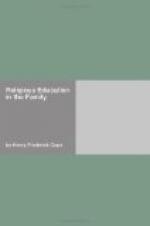5. Is fighting
necessarily wrong? What part does it play in the
lives of men?
6. What are the dangerous elements in boys’ fights?
7. What special
quality of character needs development in this
connection?
8. What are the valuable possibilities in the fighting tendency?
CHAPTER XXI
DEALING WITH MORAL CRISES (Continued)
Sec. 1. LYING
Parents are likely to be wilfully blind to the faults of their children. But some faults cannot be ignored; they must surely quicken the most indifferent parent to thought. We suffer a shock when our own child appears as a wilful liar.
“What shall I do when I catch the child in an outright lie? Surely he knows that is wrong and that he is wilfully doing the wrong!”
First, be sure whether he is “lying.” Lying means a purposeful intent to deceive by word of mouth or written word. When Charles Dickens wrote Oliver Twist he described a burglary that never happened, so far as he knew. He intended the reader to feel that it was true. Was he lying? No; because he simply used his imagination to paint a scene which was part of a great lesson he desired to teach the English public. Even had he had no great moral purpose, it would still not have been a lie, just as we do not accuse the writer of even the most frivolous novel of lying. He is simply creating, or imitating, in the field of imagination.
Imagination is the child’s native world. When the little girl says, “My dolly is sick,” she is saying that which is not so, but instead of reproving her for lying, you prepare an imaginary pill for the doll. Many children’s lies are simply elaborations of their doll- and plaything-imaginings. When my little daughter told me, and insisted upon it, that she had seen seven bears, of varied colors, on the avenue, should I have reproved her for lying? Was it not better to humor her fancy, to draw it out, to give it free play, being careful gradually to let her know that I knew it was fancy? I entered into the game with her and enjoyed it so long as we all understood it was only fancy. It is a crime to crush a child’s power of creating a world by imagination, a fair world, set in the midst of this world where things are imperfect, jarring, and disappointing, a world in which everything is always “just so.”
But one must also carefully aid the child in distinguishing between the world of fancy and the world of fact. This takes time and patience. We must not rob the life of fancy nor must we allow the habits of freedom with ideas to pass over into habits of carelessly handling realities. Along with the development of fancy we must train the powers of exact observation and statement of facts. The child who saw seven bears, red, green, yellow, etc., must go to see real bears and must tell me exactly their colors and forms. Daily training in exactitude of statements of real facts is the best antidote for a fancy that has run out of its bounds. It establishes a habit of precision in thinking which is the essence of truth-telling.




